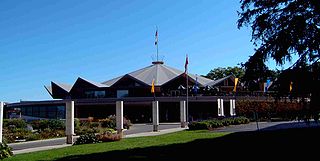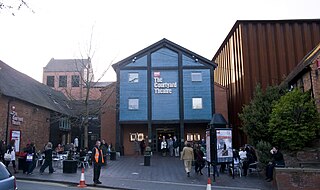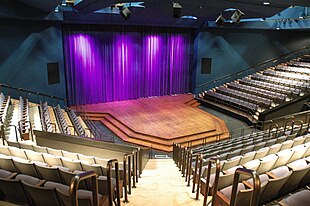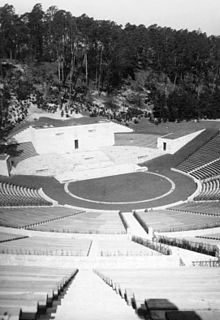
English Renaissance theatre, also known as Renaissance English theatre and Elizabethan theatre, refers to the theatre of England between 1558 and 1642.

The Royal Shakespeare Company (RSC) is a major British theatre company, based in Stratford-upon-Avon, Warwickshire, England. The company employs over 1,000 staff and opens around 20 productions a year. The RSC plays regularly in London, Stratford-upon-Avon, and on tour across the UK and internationally.

The Stratford Festival is a theatre festival which runs from April to October in the city of Stratford, Ontario, Canada. Founded by local journalist Tom Patterson in 1952, the festival was formerly known as the Stratford Shakespearean Festival, the Shakespeare Festival and the Stratford Shakespeare Festival. The festival was one of the first arts festivals in Canada and continues to be one of its most prominent. It is recognized worldwide for its productions of Shakespearean plays.

The Royal Shakespeare Theatre (RST) is a Grade II* listed 1,040+ seat thrust stage theatre owned by the Royal Shakespeare Company dedicated to the English playwright and poet William Shakespeare. It is located in the town of Stratford-upon-Avon – Shakespeare's birthplace – in the English Midlands, beside the River Avon. The building incorporates the smaller Swan Theatre. The Royal Shakespeare and Swan Theatres re-opened in November 2010 after undergoing a major renovation known as the Transformation Project.

Sir William Tyrone Guthrie was an English theatrical director instrumental in the founding of the Stratford Festival of Canada, the Guthrie Theater in Minneapolis, Minnesota, and the Tyrone Guthrie Centre at his family's ancestral home, Annaghmakerrig, near Newbliss in County Monaghan, Ireland. He is famous for his original approach to Shakespearean and modern drama.
Ben Iden Payne, also known as B. Iden Payne, was an English actor, director and teacher. Active in professional theatre for seventy years, he helped the first modern repertory theatre in the United Kingdom, was an early and effective advocate for Elizabethan staging of Shakespeare plays, and served as an inspiration for Shakespeare Companies and University theatre programmes throughout North America and the British Isles. His name lives on as the name of a theatre at the University of Texas as well as annual theatre awards presented in Austin, Texas.

A vomitorium is a passage situated below or behind a tier of seats in an amphitheatre or a stadium, through which big crowds can exit rapidly at the end of an event. They can also be pathways for actors to enter and leave stage. The Latin word vomitorium, plural vomitoria, derives from the verb vomō, vomere, "to spew forth". In ancient Roman architecture, vomitoria were designed to provide rapid egress for large crowds at amphitheatres and stadia, as they do in modern sports stadia and large theatres.

A theater, or playhouse, is a structure where theatrical works, performing arts, and musical concerts are presented. The theater building serves to define the performance and audience spaces. The facility usually is organized to provide support areas for performers, the technical crew and the audience members, as well as the stage where the performance takes place.

Shakespeare's Globe is a realistic true-to-history reconstruction of the Globe Theatre, an Elizabethan playhouse first built in 1599 for which William Shakespeare wrote his plays. Like the original, it is located on the south bank of the River Thames, in Southwark, London. The reconstruction was completed in 1997 and while concentrating on Shakespeare's work also hosts a variety of other theatrical productions. Part of the Globe's complex also hosts the Sam Wanamaker Playhouse for smaller, indoor productions, in a setting which also recalls the period.

William Bridges-Adams was an English theatre director and designer, associated closely with the Shakespeare Memorial Theatre, Stratford-upon-Avon, from 1919 until 1934.

The Other Place is a black box theatre on Southern Lane, near to the Royal Shakespeare Theatre in Stratford-upon-Avon, England. It is owned and operated by the Royal Shakespeare Company. In 2006, an earlier version of the theatre closed and reopened as the temporary and larger Courtyard Theatre, while the Royal Shakespeare and Swan Theatres were redeveloped. In March 2016, The Other Place was reinstated as a 200-seat studio theatre.
Mel Shapiro is an American theatre director and writer, college professor, and author.
Mark Lamos is an American theatre and opera director, producer and actor. Under his direction, Hartford Stage won the 1989 Tony Award for Outstanding Regional Theatre and he has been nominated for two other Tonys. For more than 15 seasons, he has been artistic director of the Westport Country Playhouse. In May 2023, he announced he will leave the post in January 2024.

Thousands of performances of William Shakespeare's plays have been staged since the end of the 16th century. While Shakespeare was alive, many of his greatest plays were performed by the Lord Chamberlain's Men and King's Men acting companies at the Globe and Blackfriars Theatres. Among the actors of these original performances were Richard Burbage, Richard Cowley, and William Kempe.
Colin George was a Welsh actor and director, who was the founding Artistic Director of the Crucible Theatre in Sheffield (1971).

Theatre of United Kingdom plays an important part in British culture, and the countries that constitute the UK have had a vibrant tradition of theatre since the Renaissance with roots going back to the Roman occupation.
The Stratford Adventure is a 1954 Oscar-nominated documentary film about the founding of the Stratford Festival. It is directed by Morten Parker for the National Film Board of Canada.

The Gdańsk Shakespeare Theatre is a Shakespearean theatre in Gdańsk, Poland. It is built on the site of a 17th-century theatre, known as the Fencing School, where English travelling players performed works of English Renaissance theatre. The leading figure in the project to construct the new theatre is Jerzy Limon, a founder of the Gdańsk Shakespeare Festival.
A Shakespeare festival is a theatre organization that stages the works of William Shakespeare continually.















